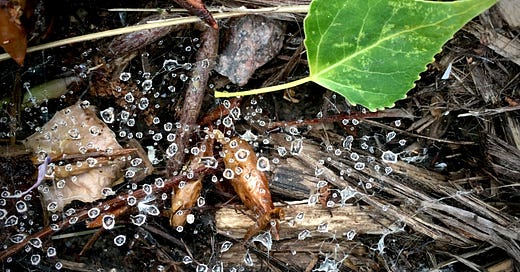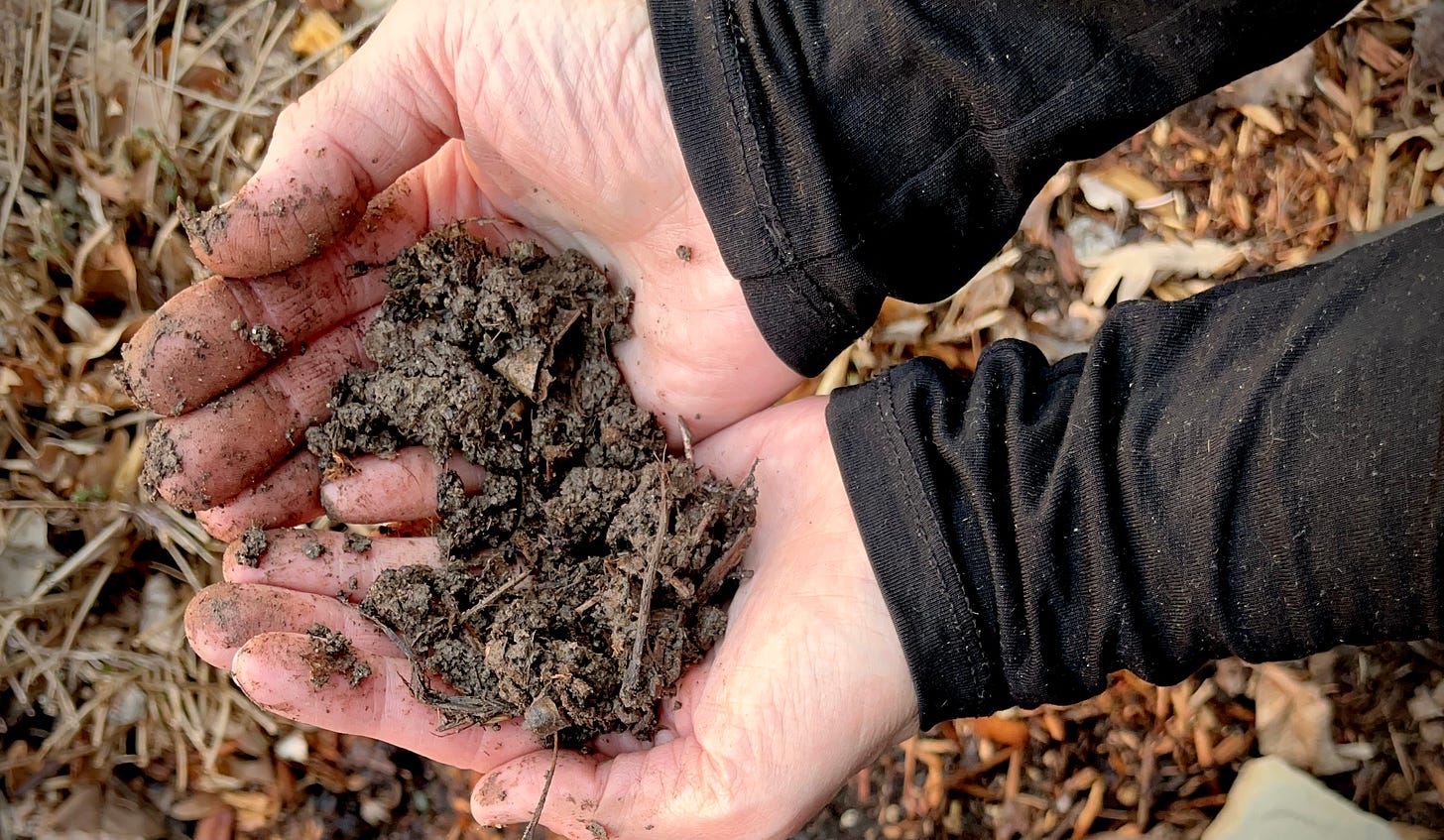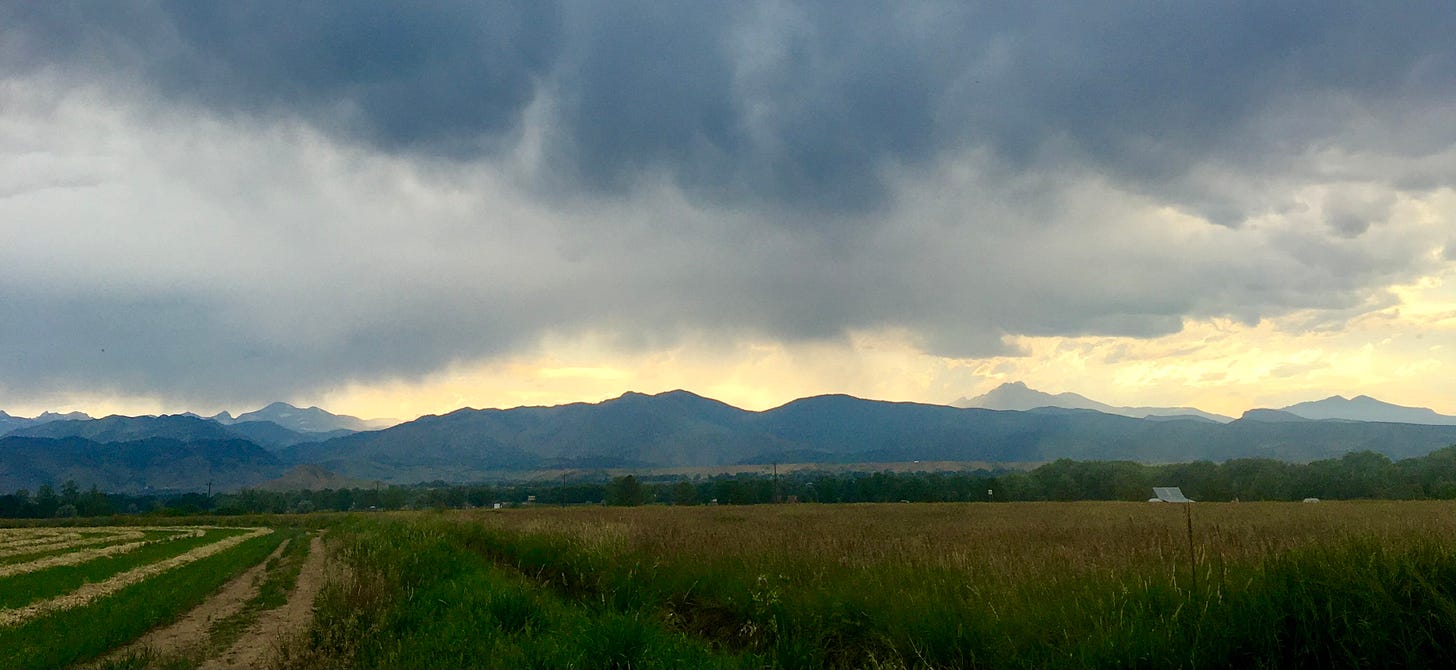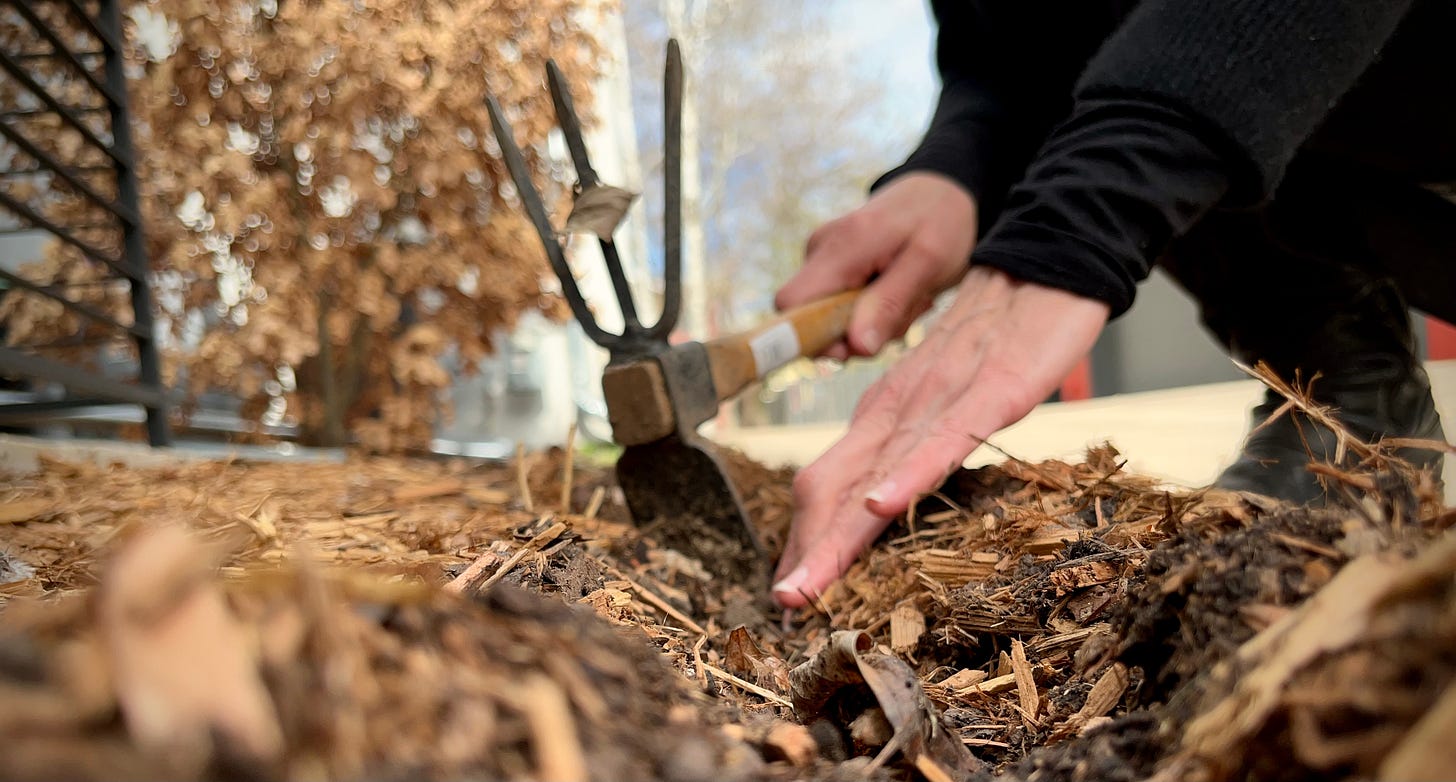Dear Reader: If you prefer to listen to this piece, click the play button on the audio below to hear me read it in my own voice, mixed with original music. The Substack app gives you a play button at the very top of the phone app which generates AI audio. I cannot turn this option off. Please support my very human voice and hear my work as it is meant to be heard, by clicking below instead. Thank you. Now, on to Skin of the Earth.
TO THINK ABOUT SOIL is to search through a thin underworld. Dark, damp, mostly silent to our ears, it holds itself within a province of absence. Do you think of it? The dirt?
After a heavy rain, earthworms congregate beneath my garage door. One by one I rescue them from both drowning and drying out. Puddles of saturate ground will suffocate. But if the worms remain tucked under cover of the garage door, as the rains subside and sun heats the concrete, their skin and the mucous it secretes will dry faster than their ability to return home. They live only a handful of years, most worms. The largest of these exhibit the fat ring around their bodies where a cocoon forms for reproduction. How many eggs already exist within this ring I cannot know. Thus, to save even a single such adult earthworm is to save multitudes.
I SPEAK TO THEM Tell them of the ground, their home, as though I know it as they do. You will be happy to be tucked in again, where the earth hugs you all around. I shuttle handfuls to dry areas of the garden under the eaves. At age five, I did the opposite, hunting nightcrawlers in order to fish for bluegills with my bamboo pole, hook, and bobber. Knowing which rocks and logs to turn, which ditches held gatherings of the fattest worms, I carried a coffee can with black dirt in the bottom and scooped with delight from ground to can as though it were a game I could win. That I now am a woman conversing as I carry in my cupped palm, as plump a nightcrawler as ever, is testament to decades spent wandering. Learning. Listening.
I HAVE BEEN ROUGH with the earth however. I have dug deep garden beds, shoveled thick clay when it was too wet, breaking the soil structure so much that it dried into hard clumps unable any longer to hold water. My mother’s garden was a huge group of squares cut into an Illinois hillside under partial shade of old oak and hickory trees not planted by anyone but the wild itself. She had a book on deep bed gardening, and gave it to me when I was grown. It involved shoveling out the upper eight to ten inches of soil to set aside. Below that, many more inches of compacted clay was dug out and mixed with manure or peat moss.
In the end, the first layers were returned to the bottom of the excavated area first, with the lower portions of soil added atop those. Skin of the earth turned upside-down, or inside out? What must the shallow dwelling earthworms have felt as they were thrust so many more inches below the surface, their burrows and tunnels in ruin? And how about the deep burrowers? Did they flail in the loose soil, in need of a pressure in which to move against?
I CAN SAY THAT THE EARTH FORGIVES what I did not know. Truth is, the layers of dirt I have delved are indifferent to my travesties. They settle and compact themselves. Are moved by worm and insect and root. Dirt doesn’t issue redemption for human errors.
THE GARDEN I HAD ONCE, in Hawaii, was comprised of ancient coral rock beds beneath a very thin layer of soil hauled in and added by the landscapers. When they installed the sprinkler system, they used a jackhammer on the coral to clear trenches for pipes. In a few short years of year-round growth, roots of palms and ferns, with monsoon tropical rains, the structure of the coral beds was broken apart. Palm leaves, plumeria, papaya, fell year round. With the help of centipedes, beetles, the Hawaiian blind snake, they were reduced to rich droppings.
Here I intently learned of the birth of Earth. In all the ways it could be born: volcanic eruption, ancient receding seas, rotting mango, rain. Here I owned two red worm bins where the worms were so happy to dissolve scraps from my kitchen, it seemed they wriggled in greeting each time I opened the lid to lay in pineapple cores and old rice. The little plot of coral beds upon which our home sat was part of a larger community resting inside and encircled by an ancient caldera, all of us held within its old old walls of lava rock.
TO THINK ABOUT SOIL is also to imagine what it holds. Charlotte Gill tells us in her wonderful book, Eating Dirt, where she lived as part of a tree-planting tribe, “If you dig out ten feet of dirt from an old-growth forest, you might find embedded within it a thousand seeds.” So encapsulated by time and our absence from any thought of such things, the dirt cradles future chances of which we have no notion.
Ours is a species who considers mostly what we can harvest from Earth’s soil in a single season. Indeed, the word harvest has its roots in the Latin word carpere, meaning pluck, and in the Greek word karpos, meaning fruit. What is grown is the fruit of the land, once seeded by its own chance of circumstance, now largely orchestrated by us. Where we have mistakenly directed what we once felt was certain growth, so too a correction must be instigated by our hands.
The Klamath River traverses Oregon into northern California and is dotted with dams along its entire body. The Klamath Tribes are leaders in the restoration of the river, having called for removal of the dams for decades. In an episode of Changing Planet, entitled River Restoration, the Klamath’s dam removal and the landscape’s recovery is documented in part.
WHERE ONCE THE RIVER’S FLOW was blocked, a false lake has receded, and the sloping banks of the Klamath emerged. Where once there was water, now there is spongy soil. Saturate and long hidden, it cracks under the sun as though it were the expansive exhalation of one long damp breath which had been held a hundred years.
So vast and fresh is this new landscape, in areas where it is difficult to re-seed on foot, the earth is being seeded by air. Helicopters raise up great swaths of gathered tarps filled with hundreds of thousands of seeds. Though we cannot know what the soil feels for that which it supports and grows, to see an abundance of seeds spill across the riverbanks from the sky is to feel the landscape open to a purpose perhaps greater than that which we are able to comprehend.
THOUGH I SOWED MY GARDEN earlier this spring with minuscule carrot and lettuce seeds, along with larger kernels of radish and nasturtium, I offer this re-seeding of earthworms under the eaves away from a too-wet earth, perhaps close to their original home. I pat-pat them into a minor scratch in the surface of the soil.
Little slit of its skin, Earth opens itself to all which is placed within, even our own bodies in full, or as ash, given time and a life completed beginning to end. For this handful of worms, with a persistence of purpose and perhaps a break from the unrelenting rains of a very wet spring, they will live on to shed their egg sacs. Their offspring will move in clusters of threaded new bodies beneath our feet with little thought from us.
I was preparing to leave for a doctor’s appointment when I discovered the worms congregated under the garage door. Now on the way, my hands on the wheel are sticky, with dark earth under fingernails. My mind continues to trace the path of the rescued, as after my appointment, I sit down in the lab for blood tests. More than a hundred of Earth’s minerals flow in my veins. Yours too. Some, so we are told, have delivered themselves to us from amongst the stars. Within our gut, we hold the same beneficial bacteria found in massive threads of fungi which link together everything rooting and rotting below the earth’s surface in a kind of web of messages. Or emotions. Or thoughts.
My arm held out to offer up my individual mixture of these ingredients into vials, the young phlebotomist turns to greet me with an inhalation and her sudden exclamation, “Ohhh..! You smell like earth!”
Perhaps we exude more than we realize. Our bodies like trees which draw up what we need from the skin of our Earth, then lift our feet as uprooted trunks to wander about while we shed a succession of cells over the course of our lives. Why wouldn’t we smell like the soil? Our relationship with this, the earth’s skin, is perhaps the most sensuous we have ever known.
I WATCH BLOOD LEAVE my body, crimson and thick, much like the ironlike worms I cradled in conversation moments before. Monse, the kind phlebotomist, and I chat about essential oils I wear (sandalwood and patchouli), our names (my middle, her first) and what we remember from the grounds where we grew up.
There is a scraggy side country road in northern Illinois where I once halted my small red bike to jump off its plastic seat and spend many minutes trying to collect stalks of wild chicory. Their cornflower blue blossoms run up and down stalks which open to sunlight, and close tight again at nightfall. It was getting dark. I had been meandering gravel side roads on my bike for what seemed like hours. I was perhaps six or seven.
The scent of that summer evening was a tang of rock dust kicked up by my bike, and the juicy oils of wild chicory mixed with the sweat of my palms upon them. The stalks would not let themselves be picked. They grow on the side of the road for a reason. They are durable. Resistant. Proud. I wanted them as a gift for my mother. I wanted what I had seen emerge from the ground as tiny spring shoots weeks earlier to become the most moody flowers I had yet seen in my young life.
Pale and somewhat sorrowful, they are jagged at the ends of straight petals. How hard it is to grow up from the ground! Harder still, to hold tight to the skin of this earth. But they did. And I, so young and absent of the experiences of this earth, bent and yanked and pulled at a single stem until it gave itself up, roots and all still clutching bits of clay dirt and stones. That the chicory barely survived the force of my want and exhilarated ride home to present the gift was an early disappointment.
“… nothing on Earth is constant,” writes Charlotte Gill, “not the weather, not the climate, not even magnetic north. The Earth’s crust is on the move, always slowly, but sometimes with great upheaval.”
After my blood draw and sharing of stories, I arrive home and pull into the garage. Near the middle is a lone earthworm in a slow struggle over concrete, moving towards the door to the house as it releases a trail of mucous in its wake. I must have overlooked it earlier. Or it was under the car when I pulled out. I stoop to lift it, still alive, but feeling not so sticky. There is a very large cocoon ring around its body. Earthworms are hermaphrodites. They equally produce an egg cocoon and entangle themselves with each other to fertilize one another’s stash. This time I find some soil which is not so dry and root around with my fingers to gauge the damp, see if there are others in residence there. Tiny, new tendrils of worms wag themselves. I set this one amongst what are hopefully kin and loosely pull the earth’s skin together again, to cover over them all.
Audio narration and mixing by Jessica Rigney. Music by Schwarzenegger Belonio (Migfus20) at Freesound. Rainstorm & thunder recording by RHumphries at Freesound.










The chicory, rising from the seam of concrete slabs in my friend’s driveway (and always lovingly left undisturbed) is near ready to bloom. I look for it every year.
I could smell the petrichor as I immersed myself in your reading and recording.
Thank you, Jessica! 💕